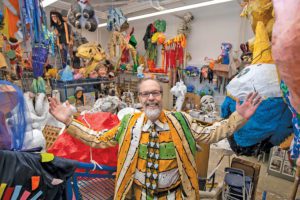After fifteen years, Tucker is saying goodbye to Ann Arbor’s giant puppet parade for new creative pursuits. FestiFools will live on through its nonprofit, WonderFool Productions, and its partnership with the Ann Arbor District Library (see Events, p. 53). But Tucker—art director and visual arts instructor for U-M’s Lloyd Scholars for Writing and the Arts—will bring his next creative gig to the U-M Museum of Art this summer.
Titled “FUN,” the exhibit invites the community to create giant, moveable sculptures inspired by objects in UMMA’s collection in a combined artists’ workshop/gallery space.
“I think for most people, FestiFools is what you see on the street, but for me it’s this experience here,” Tucker, sixty-one, says from his U-M studio on Kipke Dr., where he’s surrounded by gigantic papier-mâché puppets created by students in his Art in Public Spaces class. “This is the part that most people don’t get to see, so we’re inviting people to not just see it but create it” at the museum.
Students he’s taught over the years—mostly non-art majors—initially created public murals and community theater sets until the class added papier-mâché sculpture making. The puppets went public for FestiFools in 2007, which became a community-wide annual event the first Sunday in April. (FoolMoon, its nighttime counterpart, is the Friday of the same weekend, featuring community-made luminary sculptures.) “Our community has not just stood on the sidelines and loved it, they come in and pitch in and help,” he says, with AADL-hosted workshops and volunteers who assist U-M students with papier-mâché making, and sewing, painting, and mechanical know-how.
Tucker’s all-in approach “makes art more accessible to people in the community,” says UMMA’s Christopher Ankney. It “doesn’t want to put art on a pedestal like most museums do,” he says, and Tucker’s philosophy fits that mission. Tucker—who didn’t visit a museum until he was in college—say he hopes FUN will “bring first-time visitors over the threshold.”

Tucker at his U-M studio on Kipke Dr. “I think for most people, FestiFools is what you see on the street,” he says, “but for me it’s this experience here.” Photograph by Mark Bialek | markbialek.com
Growing up in Vermont, Tucker says he was “the weird kid who rode his unicycle to school … I was willing to upset the social norm.” While other kids were learning to ski, he was hosting variety shows and was into juggling, ventriloquism, and magic. The youngest of four kids, he says his mother “was amused by me. I was a jokester and still am.”
Married with three grown sons—one a playwright in New York, one a writer in L.A., and one in U-M’s jazz piano program—Tucker got his undergrad degree in art from Ohio Wesleyan and his MFA at U-M. Although classically trained as a painter, “I’ve learned through the years that it’s so much more delightful to work with other people.”
His senior year of college, a New York City apprenticeship with painter Joe Zucker ended prematurely when he crushed one of the painter’s works in a freight elevator on the way to a gallery showing. (Forty years later, they met by Zoom to revisit the episode for Jonathan Goldstein’s “Heavyweight” podcast: the highly entertaining result, called “Mark,” was released in December.)
Next, he was recruited by friends to assist artist Red Grooms with “Ruckus Manhattan,” a massive 3-D representation of the borough. “Years later, I realized this guy had the right model,” Tucker says, “bringing all these artists together to create something bigger than he could have on his own.”
After grad school, Tucker answered a blind ad for the Parade Company in Detroit. He built floats for its Thanksgiving parade, and during the slow season was sent to apprentice in Tuscany with the master artists of Carnival of Viareggio. “This was always the dream,” he says, pointing to photos in a Carnival book of fanciful floats with hundreds of moving parts. He asked himself, “how can I bring this back to the U.S.?”
He later worked in the Boston area as a freelance designer and scenic artist for museums, theater, ballet, and operas—and as a set painter for movies, including Good Will Hunting and Amistad. He returned to Michigan with his young family to work with the Parade Company again until he was hired by U-M.
A list of brainstormed FestiFools themes is tacked to Tucker’s office wall: Wishfool Thinking, Metamor-fool-sis, Rev-fool-ution, Fool Steam Ahead. Past events have included a cow on fire; a spinning sculpture of Putin, Trump, and Kim Jong-un; and a gigantic baby. No matter the zany student idea, “we’re rooting for them,” says Tucker. This year, in a segue to the FUN exhibit, students are working with an UMMA curator to link their creations to specific museum objects. One student is creating a 3-D interpretation of a dragon inspired by a seventeenth-century ceramic Korean vase in the museum’s collection.
“The DNA for these types of events was set even before I got here,” Tucker says, and notes that Ann Arbor’s Ozone parades of the seventies with “pickup trucks and pigs” were “even crazier.” Although this will be its last FestiFools tie-in, Tucker will continue to offer his U-M course.
After a two-year pause due to Covid, 2022 FestiFools is set for 4 to 5 p.m. Sunday, April 3, at its new location on S. State in front of UMMA. Tucker says two of his three sons will be in town for it.
“I’m gonna try to sit on the side and be a spectator instead of running around with duct tape and zip ties fixing things as they fall apart,” he says. “I’m gonna try to soak it in.”